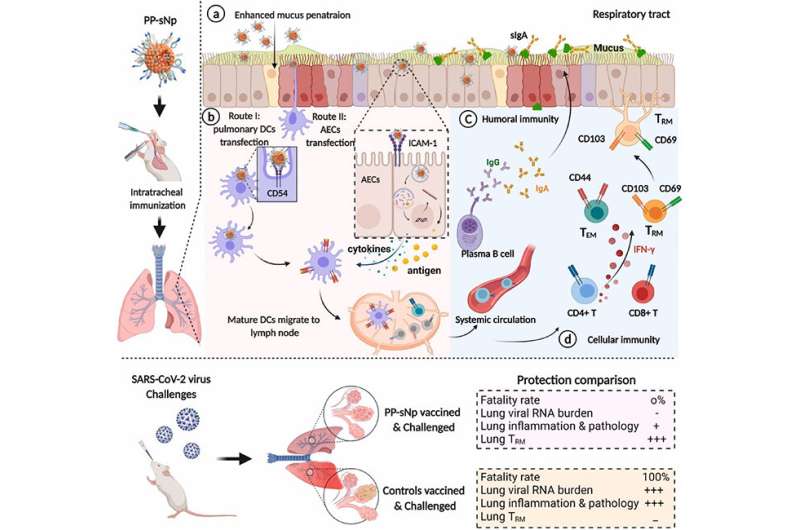Immune responses and protection against the SARS-CoV-2 virus induced by the pulmonary vaccine. a) After administration, the vaccine efficiently penetrates the physical and biological barriers of the respiratory mucous membranes. b) This extracellular-targeted vaccine penetrates the airway epithelial cells (AEC) and pulmonary dendritic cells (DC). The synthetic vector allows the vaccine DNA to enter the nuclei of the DCs and the AECs to be transcribed into RNA and translated into SARS-CoV-2 antigens. AECs simultaneously orchestrate the adaptive immune responses via the local and transient secretion of cytokines. Mature pulmonary DCs then migrate to the bronchial-associated lymphoid tissues where they present antigens to naïve T cells and B cells for humoral and cellular immune responses. c) Activated B cells proliferate and differentiate into antibody-secreting plasma cells to generate secretory IgA (sIgA) and systemic IgG antibodies, the former of which efficiently neutralizes invading SARS-CoV-2 inside the body. d) A portion of T cells obtains a tissue resident memory phenotype (TRM), enabling them to reside in the airway and respond rapidly when encountering SARS-CoV-2 virus. The robust and comprehensive immunity conferred by this new class of lung vaccine eliminates viruses from the initial sites of infection and protects 100% of the vaccinated mice. Credit: Biomaterials (2022). DOI: 10.1016/j.biomaterials.2022.121907
Less known to the general public, mucosal vaccination via the mucus membranes could provide robust protection against SARS-CoV-2 infections. Immune cells in the nose and lungs are considered better prepared to encounter and block the virus that causes COVID-19.
An international research team has just demonstrated that its mucosal DNA vaccine is capable of ensuring the total survival of a group of mice infected with a version of the virus adapted to this species, whereas the latter kills 100% of unvaccinated mice.
Created using a vector developed by a CNRS researcher at the Immunology and New Concepts in ImmunoTherapy Laboratory (CNRS/INSERM/Nantes Université/Université Angers), this vaccine acts in a manner similar to that of RNA vaccines on the market: DNA delivered by the vector enters the target cells, causing them to produce a SARS-CoV-2 protein and allowing the immune system to prepare itself by producing antibodies and lymphocytes against the virus.
The vaccine's effectiveness against transmission between mice was not measured in this study, which is published online in Biomaterials. However, scientists hope that a vaccination method based on this principle could complement the current strategy, perhaps by providing better protection against transmission.
More information: Si Sun et al, Respiratory mucosal vaccination of peptide-poloxamine-DNA nanoparticles provides complete protection against lethal SARS-CoV-2 challenge, Biomaterials (2022). DOI: 10.1016/j.biomaterials.2022.121907
Journal information: Biomaterials
Provided by CNRS
























